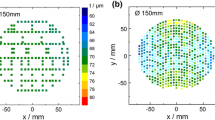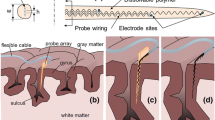Abstract
Self-expandable medical devices provide mechanical functionality at a specific location of the human body and are viable for minimal invasive procedures. Besides radiopaque markers and drug-eluting coatings, next generation self-expandable devices can be equipped with additional functionality, such as conductive and flexible electrodes, which enables chronic recording of bioelectrical signals, stimulating or ablating tissue. This promises new therapeutic options in various medical fields, among them in particular neuromodulation (e.g. deep brain stimulation), BioMEMS, radio frequency ablation, mapping or denervation. However, the fabrication of such multi-functional devices is challenging. For this study we have realized a 35 μm thick, superelastic NiTi thin film stent structure with six isolated electrodes on the outer circumference, each electrode connected to a contact pad at the end of the stent structure, using magnetron sputtering, UV lithography and wet chemical etching. Mechanical and electrical properties of the device during typical loading conditions, i.e. crimping, simulated pulsatile and electrochemical testing, were characterized and reveal promising results. For the fabrication of future multifunctional, minimal invasive medical devices, such as electroceuticals or other intelligent implants, NiTi thin film technology is therefore a versatile alternative to conventional fabrication routes.






Similar content being viewed by others
References
C. Bechtold, R. Lima de Miranda, E. Quandt, Superelasticity. Shap. Mem. (2015). doi:10.1007/s40830-015-0029-9
L.S. Castleman, S.M. Motzkin, F.P. Alicandri, V.L. Bonawit, A.A. Johnson, J. Biomed. Mater. Res. 10(5), 695 (1976)
M. Castro, A.S. Rubin, M. Laviolette, J. Fitermann, M. De Andrade Lima et al., Am. J. Respir. Crit. Care Med. 182, 2 116 (2010)
K.C. Cheung, P. Renaud, H. Tanila, K. Djupsund, Biosen. Bioelectron. 22(8), 1783 (2007)
J.W.C. de Vries, J. Phys. Met. Phys. 17, 1945 (1987)
T.W. Duerig, M. Wholey, Minim. Invasive Ther. Allied Tech. 11(4), 173 (2002)
H. Fischer, B. Vogel, A. Welle, Minim. Invasive Ther. Allied Tech. 13(4), 248 (2004)
L.A. Geddes, Annal. Biomed. Eng. 25(1), 14 (1997)
T. Habijan, R.L. De Miranda, C. Zamponi, E. Quandt, C. Greulich, T.A. Schildhauer, M. Köller, Mater. Sci. Eng. C 32(8), 2523 (2012)
C. Henle, M. Raab, J.G. Cordeiro, S. Doostkam, A. Schulze-Bonhage, T. Stieglitz, J. Rickert, Biomed. Microdevices 13(1), 59 (2011)
B.A. Hollenberg, C.D. Richards, R. Richards, D.F. Bahr, D.M. Rector, J. Neurosci. Meth. 153(1), 147 (2006)
B.-J. Kim, Y. Cho, M.-S. Jung, H.-A.-S. Shin, M.-W. Moon, H.N. Han, K.T. Nam, Y.-C. Joo, I.-S. Choi, Small 8(21), 3300 (2012)
B. Li, T. Steigauf, P. McIntyre, D. Sorensen, in Medical Device Materials V, Proceedings from the Materials & Processes for Medical Devices Conference 2009 (ASM International) p. 111
R. Lima de Miranda, C. Zamponi, E. Quandt, Adv. Eng. Mater. 15(1–2), 66 (2013)
R. Lima de Miranda, T. Scheuermann, PCT/EP2015/052026
T.J. Oxley, N.L. Opie, S.E. John, G.S. Rind, S.M. Ronayne et al., Nat. Biotechnol. 3428, 1 (2016)
B. Rubehn, C. Bosman, R. Oostenveld, P. Fries, T. Stieglitz, J. Neural Eng. 6, 036003 (2009)
J. Ryhänen, Minim. Invasiv. Ther. 9(2), 99–105 (2000)
M. Schuettler, Proc. IEEE EMBS. ThB08.6 (2007)
G. Siekmeyer, A. Schüßler, R. Lima de Miranda, E. Quandt, JMEPEG 23, 2437 (2014)
D. Stoeckel, Minim. Invasiv. Ther. 9(2), 81 (2000)
D. Stoeckel, A.R. Pelton, T.W. Duerig, in Shape Memory Alloys for Biomedical Applications, ed. by T. Yoneyama, S. Miyazaki (CRC Woodhead Publishing, 2009) pp. 237–256
A. Vanhoestenberghe, N. Donaldson, J. Neural Eng. 10, 031002 (2013)
M.E. Wechsler, M. Laviolette, A.S. Rubin, J. Fiterman, J.R. Lapa e Silva et al., J. Allerg. Clin. Immunol. 132(6), 1295 (2013)
M. Wohlschlögel, R. Lima de Miranda, A. Schüßler, E. Quandt, J. Biomed. Mater. Res. B. 104(6), 1176 (2016)
J.D. Yeager, D.J. Phillips, D.M. Rector, D.F. Bahr, J. Neurosci. Meth. 173(2), 279 (2008)
Author information
Authors and Affiliations
Corresponding author
Rights and permissions
About this article
Cite this article
Bechtold, C., de Miranda, R.L., Chluba, C. et al. Fabrication of self-expandable NiTi thin film devices with micro-electrode array for bioelectric sensing, stimulation and ablation. Biomed Microdevices 18, 106 (2016). https://doi.org/10.1007/s10544-016-0131-6
Published:
DOI: https://doi.org/10.1007/s10544-016-0131-6




